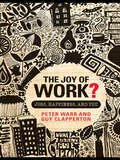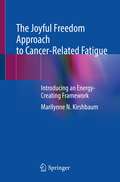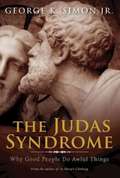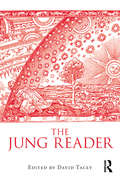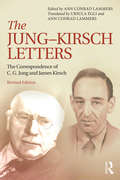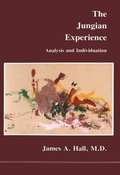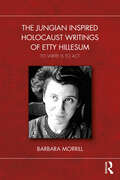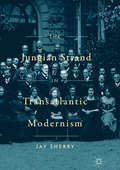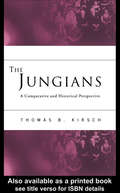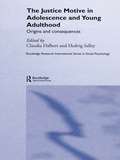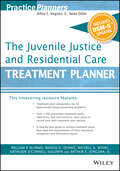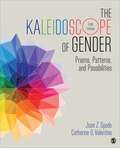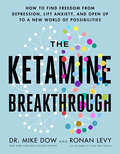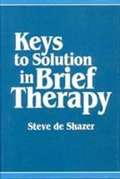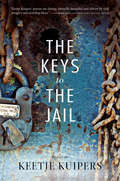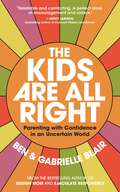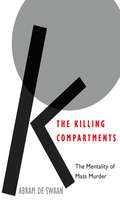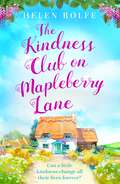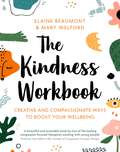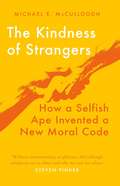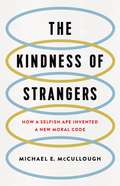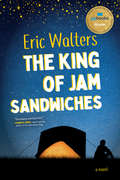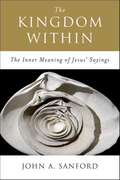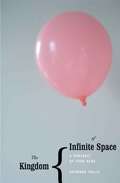- Table View
- List View
The Joy of Work?: Jobs, Happiness, and You
by Guy Clapperton Peter WarrAre you happy at work? Or do you just grin and bear it? We spend an average of 25% of our lives at work, so it’s important to make the best of it. The Joy of Work? looks at happiness and unhappiness from a fresh perspective. It draws on up-to-date research from around the world to present the causes and consequences of low job satisfaction and gives helpful suggestions and strategies for how to get more enjoyment from work. The book includes many interesting case studies about individual work situations, and features simple self-completion questionnaires and procedures to help increase your happiness. Practical suggestions cover how to improve a job without moving out of it, advice about changing jobs, as well as how to alter typical styles of thinking which affect your attitudes. This book is unique. The subject is of major significance to virtually all adults - people in jobs and those who are hoping to get one. It is particularly distinctive in combining two areas that are usually looked at separately – self-help approaches to making yourself happy and issues within organizations that affect well-being. The Joy of Work? has been written in a relaxed and readable style by an exceptional combination of authors: a highly-acclaimed professor of psychology and a widely published business journalist. Bringing together research from business and psychology – including positive psychology – this practical book will make a big difference to your happiness at work – and therefore to your whole life.
The Joyful Freedom Approach to Cancer-Related Fatigue: Introducing an Energy-Creating Framework
by Marilynne N. KirshbaumThe book introduces The Joyful Freedom Approach, as a strategy for recovery from fatigue. It was initially developed through a series of research studies inspired initially by women who had breast cancer and were troubled by ongoing cancer-related fatigue. The integrated, holistic approach has scope for supporting individuals who have experienced energy depletion not just due to cancer and its treatments, but also in relation to other illnesses, conditions or distressing life events. The approach is aimed at helping people to discover what they can do to energise their lives following an event such as cancer that has left them lacking vitality, wellness or a sense of direction and clarity about how to live life fully. Research has culminated in identifying five attributes of energy restorative activities; these are represented by the Energy Restoration Framework. The attributes of Purposeful Expanding, Connecting/Belonging, Awe-inspiring and Nourishing act as headings for discussion, planning and integration into an individual’s recovery and beyond. The book is organised into three parts and subdivided into chapters. Part One contains the chapters of: The Inspiration, The Challenge and the Resolution. These first chapters offer the reader a gateway to the Joyful Freedom Approach starting with a narrative that starts from nursing practice and discovering energy-fields, through to the foundations and detail surrounding evidence-based research on cancer-related fatigue and possible interventions. Part Two consists of chapters that serve to place the energy-creating framework in context: Philosophy and Theory; Evidence for Change and Research in Practice. Here, the influential Attention Restorative Theory of Professor Stephen Kaplan, an environmental psychologist, is introduced. The discussion then progresses onto the adaptation of Kaplan’s theory to the cancer care and illness context. Part Three provides an overview and representation of The Energy Restoration Framework leading to the emergence of the Joyful Freedom Approach. The book concludes with a discussion of how theory and practice can be brought together and applied using The Joyful Freedom Approach. The book is aimed at health care practitioners who are engaged with counselling people through distressing life events. This would include nurses, medical doctors, social workers or occupational therapists who work with individuals who are recovering from illnesses or surgery, or mental health practitioners who help their clients to regain control and navigate through distressing life events. The book offers practitioners and therapists an evidenced-based template that is versatile and adaptable to meet the needs of a varied range of clients.
The Judas Syndrome: Why Good People Do Awful Things
by Dr George K. Simon Jr.Even people we think are our friends will deny and betray us. Are they bad people, or just don't do enough, or people with good intentions but acting in ignorance? Or are they basically decent people who, when put to the test, fail because of their weak faith? Filled with many examples, Judas Syndrome gives concrete ways to prevent people, even other Christians, from hurting you and the role that faith can play in changing them and helping you avoid the pain that these relationships often bring. Although sometimes we suffer as a result of our own shortcomings and missteps, placing our trust in Christ's message of love provides the gateway to the life God intends for us. In other words, faith can really save us--a faith, however, that is not easily undertaken on a daily basis or one that can be sustained alone.
The Jung Reader
by David TaceyCarl Gustav Jung was the pioneering founder of analytical psychology, a form of analysis that has revolutionised the approach to mental illness and the study of the mind. In this anthology, David Tacey brings together a selection of Jung's essays from his famous Collected Works. Divided into four parts, each with a brand new introduction, this book considers 17 of Jung’s most important papers covering: the nature of the psyche archetypes religion and culture therapy and healing. This accessible collection is essential reading for undergraduates on analytical psychology courses, those on psychotherapy training courses, and students studying symbolism and dreams, or archetypal approaches to literature, cinema, religious studies, sociology or philosophy. The text is an informative introduction for general readers as well as analysts and academics who want to learn more about C. G. Jung's contribution to psychoanalysis, and how his ideas are still extremely relevant in the world today.
The Jung-Kirsch Letters: The Correspondence of C.G. Jung and James Kirsch
by Ann Conrad LammersThis book charts Carl Gustav Jung’s 33-year (1928-61) correspondence with James Kirsch, adding depth and complexity to the previously published record of the early Jungian movement. Kirsch was a German-Jewish psychiatrist, a first-generation follower of Jung, who founded Jungian communities in Berlin, Tel Aviv, London, and Los Angeles. Their letters tell of heroic survival, brilliant creativity, and the building of generative institutions, but these themes are darkened by personal and collective shadows. The Nazi era looms over the first half of the book, shaping the story in ways that were fateful not only for Kirsch and his career but also for Jung and his. Kirsch trained with Jung and acted as a tutor in Jewish psychology and culture to him. In 1934, fearing that anti-Semitism had seized his teacher, Kirsch challenged Jung to explain some of his publications for the Nazi-dominated Medical Society for Psychotherapy. Jung’s answer convinced Kirsch of his sincerity, and from then on Kirsch defended him fiercely against any allegation of anti-Semitism. We also witness Kirsch’s lifelong struggle with states of archetypal possession: his identification with the interior God-image on the one hand, and with unconscious feminine aspects of his psyche on the other. These complexes were expressed, for Kirsch, in physical symptoms and emotional dilemmas, and they led him into clinical boundary violations which were costly to his analysands, his family and himself. The text of these historical documents is translated with great attention to style and accuracy, and generous editorial scaffolding gives glimpses into the writers’ world. Four appendices are included: two essays by Kirsch, a series of letters between Hilde Kirsch and Jung, and a brief, incisive essay on the Medical Society for Psychotherapy. This revised edition includes primary material that was unavailable when the book was first published, as well as updated footnotes and minor corrections to the translated letters.
The Jungian Experience: Analysis and Individuation
by James W. HallThe author's experience and interpretation of studying and practicing Jungian Psychology.
The Jungian Inspired Holocaust Writings of Etty Hillesum: To Write is to Act
by Barbara MorrillWithin this fascinating new book, Barbara Morrill analyses the journal writings of Etty Hillesum, a young Jewish woman in the 1940s, as she began analysis with a Jungian oriented practitioner in 1941.While Anne Frank is an inspirational figure, little is known about Etty Hillesum, also from Amsterdam, who kept a diary recounting her life and experiences during early World War II. This book is a compelling example of how we can use Etty Hillesum’s writings in the present to stand firm against the problems we’re currently facing globally. Being a Jungian oriented Integral psychologist and professor, the author examines what Hillesum recorded in her time, as well as employing Etty’s ideas to illuminate the chaos in our time. She explores Hillesum’s own process of individuation and realization, encouraging others to “develop yourselves!”This will be a unique volume of interest to Jungian analysts, analysts in training, as well as readers with an interest in the time period and concern about democracy and “our times.”
The Jungian Strand in Transatlantic Modernism
by Jay SherryIn studies of psychology’s role in modernism, Carl Jung is usually relegated to a cameo appearance, if he appears at all. This book rethinks his place in modernist culture during its formative years, mapping Jung’s influence on a surprisingly vast transatlantic network of artists, writers, and thinkers. Jay Sherry sheds light on how this network grew and how Jung applied his unique view of the image-making capacity of the psyche to interpret such modernist icons as James Joyce and Pablo Picasso. His ambition to bridge the divide between the natural and human sciences resulted in a body of work that attracted a cohort of feminists and progressives involved in modern art, early childhood education, dance, and theater.
The Jungians: A Comparative and Historical Perspective
by Thomas B. KirschThe Jungians: A Comparative and Historical Perspective is the first book to trace the history of the profession of analytical psychology from its origins in 1913 until the present.As someone who has been personally involved in many aspects of Jungian history, Thomas Kirsch is well equipped to take the reader through the history of the 'movement', and to document its growth throughout the world, with chapters covering individual geographical areas - the UK, USA, and Australia, to name but a few - in some depth. He also provides new information on the ever-controversial subject of Jung's relationship to Nazism, Jews and Judaism. A lively and well-researched key work of reference, The Jungians will appeal to not only to those working in the field of analysis, but would also make essential reading for all those interested in Jungian studies.
The Justice Motive in Adolescence and Young Adulthood: Origins and Consequences (Routledge Research International Series in Social Psychology #Vol. 8)
by Claudia Dalbert Hedvig SallayThis book provides a unique overview of the development of justice-related beliefs in different socialization contexts, and also of the role this plays in protecting mental health and promoting career development for adolescents and young adults. A range of European contributors bridge the conceptual gap between social and developmental psychological perspectives and use a number of original case-studies. This book provides new insights for justice psychology and adds new and important perspectives to studies on youth development.
The Juvenile Justice and Residential Care Treatment Planner, with DSM 5 Updates (PracticePlanners)
by Arthur E. Jongsma Jr.This timesaving resource features: Treatment plan components for 28 behaviorally based presenting problems Over 1,000 prewritten treatment goals,objectives, and interventions—plus space to record your own treatment plan options A step-by-step guide to writing treatment plans that meet the requirements of most insurance companies and third-party payors The Juvenile Justice and Residential Care Treatment Planner provides all the elements necessary to quickly and easily develop formal treatment plans that satisfy the demands of HMOs, managed care companies, third-party payers, and state and federal review agencies. Saves you hours of time-consuming paperwork, yet offers the freedom to develop customized treatment plans for juvenile clients Organized around 28 main presenting problems, from depression and abandonment issues to truancy, substance abuse, family instability, and others Over 1,000 well-crafted, clear statements describe the behavioral manifestations of each relational problem, long-term goals, short-term objectives, and educational interventions Easy-to-use reference format helps locate treatment plan components by behavioral problem or DSM-5™ diagnosis Includes a sample treatment plan that conforms to the requirements of most third-party payers and accrediting agencies (including HCFA, TJC, and NCQA)
The Kaleidoscope of Gender: Prisms, Patterns, and Possibilities (Fifth Edition)
by Joan Z. Spade Catherine G. ValentineIn this anthology, scholars explain how the complex, evolving pattern of gender is constructed interpersonally, institutionally, and culturally, and challenges students to question how gender shapes their daily lives.
The Ketamine Breakthrough: How to Find Freedom from Depression, Lift Anxiety, and Open Up to a New World of Possibilities
by Dr. Mike Dow Ronan LevyNew York Times best-selling author Dr. Mike Dow and Ronan Levy, founder of Field Trip, the world's largest provider of psychedelic-assisted psychotherapies, offer ways to integrate ketamine into treatment for depression, anxiety, PTSD, and more.It&’s been described as the most important breakthrough in mental health since the introduction of Prozac in 1986. And though once considered taboo, the psychedelic compound, ketamine, is experiencing a spectacular therapeutic comeback.When combined with psychotherapy, ketamine, which has been described as the being possibly the &“most important breakthrough in antidepressant treatment in decades,&” has the potential to treat depression, anxiety, PTSD, and other debilitating mental illnesses—and change lives.Unlike antidepressants, which merely mask the pain, psychedelics that heal the brain are the future. Instead of putting Band-Aids on the brain, with Ketamine Assisted-Psychotherapy, you can actually repair the neurological damage caused by stress, anxiety, neglect, and abuse.In this book, best-selling author Dr. Mike Dow and Field Trip co-founder Ronan Levy provide a broad overview of where KAP came from, how it works, who it works for, and what to expect. More importantly, The Ketamine Breakthrough gives specific protocols for both practitioners and patients to follow in their work with KAP.This book contains hope for those diagnosed with treatment-resistant depression, plagued by trauma and frozen by fears. Ketamine-assisted psychotherapy has also proven effective for people with drug, alcohol, and behavioral addictions, existential depression, grief, and just feeling stuck. People with unresolved resentments, anger, and the everyday anxieties of modern life will also benefit. Ketamine-assisted psychotherapy has been enormously helpful with couples, groups, and veterans, which will be addressed in the book as well.This is the go-to manual for therapists and anyone who wants to learn more about Ketamine-Assisted Psychotherapy. For those undergoing this revolutionary protocol, it includes a session-by-session Ketamine-Assisted Psychotherapy Workbook to enhance and deepen the treatment.
The Keys To Solution In Brief Therapy
by Steve De ShazerJoin de Shazer behind the on-way mirror for a fascinating journey into the land of brief therapy, where the emphasis is not on how problems arise, but on how to solve them. His case examples read like well-written detective novels, and his concept of 'skeleton key' interventions is both provocative and promising. This is a book that is firmly grounded in the tradition of Milton Erickson, but that extends Erickson's work into new areas.
The Keys to the Jail (American Poets Continuum)
by Keetje KuipersThe Keys to the Jail asks the question of who is to blame for all we’ve lost, calling us to reexamine the harsh words of failed love, the aging of a once-beautiful body, even our own voracious desires. Keetje Kuipers is a poet of daring leaps and unflinching observations, whose richly textured lyrics travel from Montana’s great wildernesses to the ocean-fogged streets of San Francisco as they search out the heart that’s lost its way.Dolores ParkIn the flattening California dusk,women gather under palms with their bagsof bottles and cans. The grass is featheredwith the trash of the day, paper napkinsblowing across the legs of those who stilldrown on a patchwork of blankets. Shirtlessin the phosphorescent gloom of streetlamps,they lie suspended. This is my one goodlife-watching the exchange of embraces,counting the faces assembled outsidethe ice-cream shop, sweet tinge of urine bythe bridge above the tracks, broken bike lockof the gay couple’s hands, desperate clappingof dark pigeons-who will take it from me?A former Wallace Stegner Fellow in Poetry, Keetje Kuipers's debut collection, Beautiful in the Mouth, won the A. Poulin, Jr. Poetry Prize. She has been the Margery Davis Boyden Wilderness Writing Resident, and is currently an assistant professor at Auburn University.
The Kids Are All Right: Parenting with Confidence in an Uncertain World
by Gabrielle Stanley Blair Ben BlairFrom Design Mom blogger Gabrielle Blair and her husband, Ben Blair, a unique guide that subverts the concept of "perfect parenting" by embracing uncertainty. Gabrielle and Ben Blair have been raising kids for over two decades. Through the years, they&’ve charted their own unconventional path: working from home before remote work was a thing; uprooting their kids four, five, six times – including a move to France where they enrolled in local schools without knowing the language. It&’s been a unique parenting journey characterized by experimentation, trial and error, decisions prompted by financial or psychological necessity, varying levels of anxiety and tension, despair, and hope. This unique path turned out to be fertile soil for growing independent, resilient, and creative kids, and a family that is genuinely close and truly enjoys each other&’s company. With this book they share how they did it, and how we can too: by letting go of tired expectations of what it means to be a good parent (focus less on grades and more on seeing your kid for who they are); by accepting that the old rules won&’t necessarily apply in the future (changes in higher ed and career-building are evolving at a rapid pace) and instead focus on making your time with your kids one of connection, adventure, shared projects, creativity and joy. And it doesn&’t require moving to France!
The Killing Compartments
by Abram De SwaanThe twentieth century was among the bloodiest in the history of humanity. Untold millions were slaughtered. How people are enrolled in the service of evil is a question that continues to bedevil. In this trenchant book, Abram de Swaan offers a taxonomy of mass violence that focuses on the rank-and-file perpetrators, examining how murderous regimes recruit them and create what De Swaan calls the "killing compartments” that make possible the worst abominations without apparent moral misgiving, without a sense of personal responsibility, and, above all, without pity. De Swaan wonders where extreme violence comes from and where it goes#151;seemingly without a trace#151;when the wild and barbaric gore is over. And what about the perpetrators themselves? Are they merely and only the product of external circumstance? Or is there something in their makeup that disposes them to become mass murderers? Drawing on a wide range of disciplines, including sociology, anthropology, political science, history, and psychology, De Swaan sheds new light on an urgent and intractable pathology that continues to poison peoples all over the world.
The Kindness Club on Mapleberry Lane
by Helen Rolfe'A warm, comforting tale of family and community which brims with kindness and love' Annie Lyons'A heartwarming story about family, forgiveness and the importance of kindness... If you're looking for a feelgood novel in these difficult times, this is definitely it!' Fiona HarperThe smallest things can make the biggest difference...Veronica Beecham's cottage is the neatest house on Mapleberry Lane. A place for everything, and everything in its place - that's her motto. But within her wisteria-covered walls, Veronica has a secret: she's hardly left her perfect home in years.Then her teenage granddaughter, Audrey, arrives on the doorstep, and Veronica's orderly life is turned upside down. Shy and lonely, Audrey is struggling to find her place in the world. As a bond begins to form between the two women, Audrey develops a plan to give her gran the courage to reconnect with the community - they'll form a kindness club, with one generous action a day to help someone in the village, and perhaps help each other at the same time. As their small acts of kindness begins to ripple outwards, both Veronica and Audrey find that with each passing day, they feel a little braver. There's just one task left before the end of the year: to make Veronica's own secret wish come true...A heartwarming story with community at its heart, about the little kindnesses that make the world a better place. Perfect for fans of Cathy Bramley and Holly Hepburn!***Readers adore Helen's heartwarming storytelling'Enchanting... Employing all the warmth and charm of Maeve Binchy, and a special brand of kindness that she has made her own, Rolfe weaves together elements of mystery, romance, family relationships and the warmth of community in a story guaranteed to bring laughter, tears and miles of smiles' Lancashire Post'A lovely community, full of friendship and love''I enjoyed every minute of this book and found it very hard to put down''Lovely, feel-good...filled with lots of love''Gave you all the emotions: suspense, happiness and excitement''Helen Rolfe's writing brought a smile to my face''Loved loved loved this fabulous book''Full of wonderful characters, great food, a lovely location'
The Kindness Workbook: Creative and Compassionate Ways to Boost Your Wellbeing
by Dr Mary Welford Dr Elaine BeaumontGrowing up is a juggling act. Our bodies and hormones change, usually at the same time as important decisions about our future need to be made. We often put extra pressure on ourselves, compare ourselves unfavourably to others and excessively worry about what other people think. Add in exams, interviews, relationships, social media, peer pressure, celebrity culture and everyday stressors, and it's no wonder our wellbeing can take a nosedive. The Kindness Workbook is a modern-day guide to help people navigate such complex times and combines amazing ideas and practices from a variety of therapies including: Acceptance and Commitment Therapy, Cognitive Behavioural Therapy, Compassion Focused Therapy, Counselling and Expressive Therapy. Using creative exercises, examples and prompts, The Kindness Workbook teaches the skills of problem-solving using guided imagery, mindfulness, mind maps, vision boards, letter-writing, music, physical activity, drama and art. It has a number of icons to help signpost different sections and has eye-catching illustrations and worksheets, all of which aim to give your wellbeing a boost. A must-have book for young people and anyone working with young people to enhance wellbeing. Your kindness journey starts right here. So, it's time to become your own best friend, instead of your own worst enemy.
The Kindness Workbook: Creative and Compassionate Ways to Boost Your Wellbeing
by Elaine Beaumont Mary WelfordGrowing up is a juggling act. Our bodies and hormones change, usually at the same time as important decisions about our future need to be made. We often put extra pressure on ourselves, compare ourselves unfavourably to others and excessively worry about what other people think. Add in exams, interviews, relationships, social media, peer pressure, celebrity culture and everyday stressors, and it's no wonder our wellbeing can take a nosedive. The Kindness Workbook is a modern-day guide to help people navigate such complex times and combines amazing ideas and practices from a variety of therapies including: Acceptance and Commitment Therapy, Cognitive Behavioural Therapy, Compassion Focused Therapy, Counselling and Expressive Therapy. Using creative exercises, examples and prompts, TheKindnessWorkbook teaches the skills of problem-solving using guided imagery, mindfulness, mind maps, vision boards, letter-writing, music, physical activity, drama and art. It has a number of icons to help signpost different sections and has eye-catching illustrations and worksheets, all of which aim to give your wellbeing a boost. A must-have book for young people and anyone working with young people to enhance wellbeing. Your kindness journey starts right here. So, it's time to become your own best friend, instead of your own worst enemy.
The Kindness of Strangers: How a Selfish Ape Invented a New Moral Code
by Michael E. McCulloughWhy do we give a damn about strangers? Altruism is unique to the human species. It is also one of the great evolutionary puzzles, and we may be on the brink of solving it. It turns out that, over the last 12,000 years, we have become more and more altruistic. This is despite the fact that, the majority of the time, our minds are still breathtakingly indifferent to the welfare of others. In solving the enigma of generosity in a world of strangers, McCullough takes us on a sweeping history of society and science to warn that, if we are not careful, our instincts and sympathies have as much potential for harm as for good. The bad news is that we are not designed to be kind. The good news is that we can push ourselves to be kind anyway, together.
The Kindness of Strangers: How a Selfish Ape Invented a New Moral Code
by Michael E. McCulloughA sweeping psychological history of human goodness -- from the foundations of evolution to the modern political and social challenges humanity is now facing. How did humans, a species of self-centered apes, come to care about others? Since Darwin, scientists have tried to answer this question using evolutionary theory. In The Kindness of Strangers, psychologist Michael E. McCullough shows why they have failed and offers a new explanation instead. From the moment nomadic humans first settled down until the aftermath of the Second World War, our species has confronted repeated crises that we could only survive by changing our behavior. As McCullough argues, these choices weren't enabled by an evolved moral sense, but with moral invention -- driven not by evolution's dictates but by reason. Today's challenges -- climate change, mass migration, nationalism -- are some of humanity's greatest yet. In revealing how past crises shaped the foundations of human concern, The Kindness of Strangers offers clues for how we can adapt our moral thinking to survive these challenges as well.
The King of Jam Sandwiches
by Eric WaltersKey Selling Points In The King of Jam Sandwiches , ayoung teen is afraid to let anyone know what is going on at home. This book examines the effects of mental illness, poverty and parental neglect. This is a very personal story for Eric Walters, informed by his own experience. Eric Walters has written over 100 books and is an avid presenter visiting thousands of students each year.
The Kingdom Within: The Inner Meanings of Jesus' Sayings
by John A. SanfordA psychoanalyst and episcopal priest presents a Jungian understanding of Christ’s teaching in this revised edition of a spiritual classic.By showing how Jesus’ teachings relate to our inner depths, The Kingdom Within guides us toward a more conscious and creative life. John A. Sanford explores the significance of Jesus’ teachings for our interior life—that inner reality that Jesus called “the kingdom of God.” It is Sanford’s conviction that contemporary Christianity has overlooked this inner dimension of Jesus’ teachings and so has lost touch with the human soul.Illustrated with case histories and dream material drawn from the author’s work as a psychotherapist, The Kingdom Within examines such characteristics as extroversion and introversion, masculinity and femininity, thinking and feeling, and sensation and intuition to show how Jesus met the criteria of wholeness or fullness of personhood. Step by step, Sanford helps us to shed the outer mask, to eschew sin, which “means living in enslavement to what we don’t know about ourselves,” and to follow the road of consciousness, which leads to “a great treasure waiting only to be discovered.”
The Kingdom of Infinite Space: A Portrait of Your Head
by Raymond TallisIn this path-breaking book, one of Britain's most eloquent and original thinkers writes about the head, what happens in it, and how it is and is not connected to our sense of identity and consciousness. Blending science, philosophy, and humor, Raymond Tallis examines the extraordinarily complex relationship we have with our heads. His aim, as he says, "is to turn readers into astonished tourists of the piece of the world that is closest to them, so they never again take for granted the head that looks at them from the mirror." Readers will delight that this is precisely what he accomplishes. The voyage begins with a meditation on the self-portrait of a mirror image, followed by a consideration of the head's various secretions. Tallis contemplates the air we exhale; the subtle meanings of nods, winks, and smiles; the mysteries of hearing, taste, and smell. He discusses the metaphysics of the gaze, the meaning of kissing, and the processes by which the head comes to understand the world. Along the way he offers intriguing digressions on such notions as "having" and "using" one's head, and enjoying and suffering it. Tallis concludes with his thoughts on the very thing the reader's head has been doing throughout the book: thinking.
